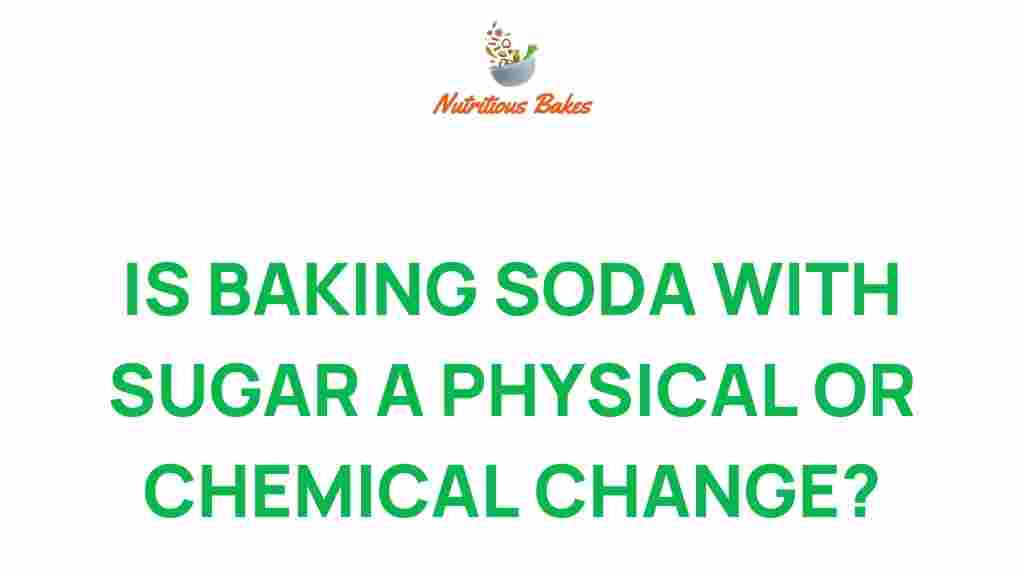The Surprising Science: Is Mixing Baking Soda and Sugar a Change?
In the realm of culinary chemistry, the kitchen is a playground for experimentation. One common question that arises is whether mixing baking soda and sugar results in a chemical change or a physical change. This is an intriguing topic for anyone interested in food science and kitchen experiments. In this article, we will delve into the science behind the interaction between baking soda and sugar, exploring the concepts of chemical and physical changes, and the reactions that can occur in your kitchen.
Understanding the Basics: Baking Soda and Sugar
Before we dive deeper into the science, let’s clarify what we mean by baking soda and sugar:
- Baking Soda: Also known as sodium bicarbonate, baking soda is a white crystalline powder that acts as a leavening agent in baking. It reacts with acids to produce carbon dioxide gas, which helps dough rise.
- Sugar: This is a sweet crystalline substance, primarily sucrose, that is used in a variety of culinary applications to sweeten and enhance flavors.
When mixed together, these two substances might seem harmless, but understanding their properties and potential reactions is essential in culinary chemistry.
Physical Change vs. Chemical Change
To determine whether mixing baking soda and sugar results in a chemical or physical change, we need to understand the differences between these two types of changes:
- Chemical Change: This occurs when substances undergo a transformation that changes their chemical composition. Indicators of a chemical change include the formation of gas, a change in color, or the release or absorption of energy (heat).
- Physical Change: This refers to a change that does not affect the chemical composition of a substance. Examples include changes in state (solid, liquid, gas) or mixing substances without altering their individual properties.
When baking soda and sugar are combined, they primarily create a mixture, which is a combination of two substances without any chemical reaction occurring. This suggests that mixing them is a physical change. However, the discussion is more nuanced, as various factors can influence this outcome.
The Science Behind the Reaction
While simply mixing baking soda and sugar does not lead to a chemical change, the conditions under which they are combined can lead to interesting reactions. Here are a few scenarios to consider:
1. Baking Soda in Baking
When baking soda is combined with acidic ingredients, such as vinegar or buttermilk, a chemical reaction occurs. This reaction produces carbon dioxide gas, which causes baked goods to rise. In this case, the presence of sugar can also enhance the flavor and browning of the final product.
2. Caramelization and Maillard Reaction
When sugar is heated, it undergoes a process called caramelization, which is a chemical change that results in the formation of new compounds with distinct flavors and colors. If baking soda is added during this process, it can influence the pH and accelerate the Maillard reaction, which occurs between amino acids and reducing sugars, creating a rich brown color and complex flavors.
3. Kitchen Experiments
To observe the reactions more closely, you can conduct simple kitchen experiments that explore the interplay between baking soda, sugar, and other ingredients. Here’s a basic experiment:
Step-by-Step Kitchen Experiment
**Experiment: Baking Soda and Sugar Reaction with Vinegar**
- Materials Needed:
- 1 teaspoon of baking soda
- 1 tablespoon of sugar
- 1/4 cup of vinegar
- A clear container
- Instructions:
- In a clear container, mix the baking soda and sugar together.
- Slowly pour the vinegar into the mixture.
- Observe the reaction that occurs.
**Expected Outcome:** When the vinegar is added, you should see fizzing and bubbling as carbon dioxide gas is released. This is a clear indication of a chemical change due to the reaction between the baking soda and the vinegar.
Troubleshooting Tips
If you do not observe a reaction during your experiment, consider the following troubleshooting tips:
- Ensure that your baking soda is fresh and active. Old or expired baking soda may not react effectively.
- Check the acidity of your vinegar. If it is too diluted or not acidic enough, the reaction may be minimal.
- Make sure you are mixing the ingredients in the correct order. The vinegar should be added last to initiate the reaction.
Applications in Culinary Chemistry
The interaction between baking soda and sugar is not only fascinating from a scientific viewpoint but also has practical applications in culinary chemistry. Here are some ways these ingredients are used:
- Leavening Agents: In baking, the combination of baking soda with acidic ingredients helps create light and fluffy baked goods.
- Flavor Enhancement: Sugar not only sweetens but also enhances the flavors of other ingredients when heated.
- Color Development: The Maillard reaction and caramelization can lead to appealing colors and complex flavors in food.
Conclusion: The Science of Mixing Baking Soda and Sugar
In conclusion, mixing baking soda and sugar in itself is a physical change, as no new substances are formed when they are combined. However, the potential for chemical changes arises when additional ingredients, such as acids, are introduced. Understanding these concepts can elevate your kitchen experiments and deepen your appreciation for the science of cooking.
By exploring reactions and experimenting with the properties of baking soda and sugar, you can better understand the principles of food science and culinary chemistry. So the next time you find yourself in the kitchen, consider the surprising science behind your ingredients!
For further reading on food science and reactions in the kitchen, check out this comprehensive guide to culinary chemistry. And if you’re interested in more kitchen experiments, visit our experiment resource page for ideas and tips.
This article is in the category Tips and created by NutritiousBakes Team
